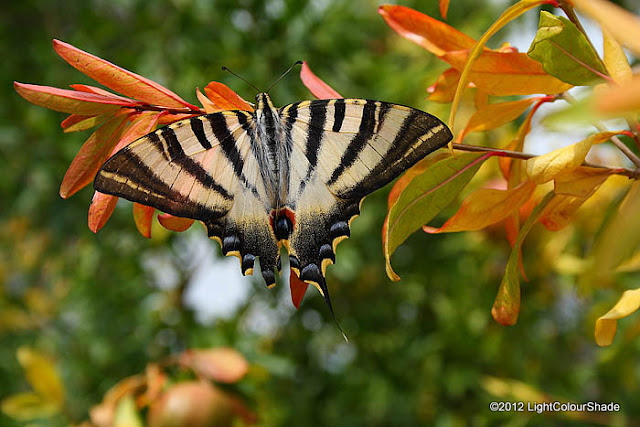 |
| Roller dung beetle digging a burrow. (© 2012 LightColourShade. All rights reserved) |
Catching the fleeting scenes of many splendored life
'Look closely. The beautiful may be small' — Kant
28 September 2012
Dung beetles and Other Things on a Sandy Beach
Dung beetles are beetles that feed partly or exclusively on faeces, that is, they are nature's garbage collectors. All these species belong to the super family Scarabaeoidea. This roller beetle in particular is also referred to as the scarab beetle, and as most species of Scarabaeinae (often dubbed true dung beetles), it feeds exclusively on faeces. Apart from being important at providing ecosystem services, it's also an example of nature's feat of engineering — I'm referring to its wings. It's fascinating the way this amazing creature unfurls its transparent foldaway wings and takes off like a chopper, or folds its wings after landing along the veins, and then carefully tucks them under the elytra (a shell-like protection).
22 September 2012
Flowering trees. Lace Bark Tree
The lace-bark tree is a tree native to Jamaica, known botanically as Lagetta lintearia from its native name lagetto. It belongs to the family Thymelaeaceae. The inner bark consists of numerous concentric layers of interlacing fibres resembling in appearance lace. The fibre is used in the manufacture of collars and other articles of apparel, as well as whips. But I especially love it for its thick petalled velvety pink flowers.
+flower.jpg) |
| Lace-bark tree (Lagetta+lintearia) flower. (© 2012 LightColourShade. All rights reserved) |
16 September 2012
Blue Passion Flower (Passiflora Caerulea).
I’ve always had a fascination with nature, that is, animals, plants and the rest, especially the unusual ones.
The first time I saw this flower it struck me as otherworldly — its complex structure makes it look like an alien artefact, but it's yet another nature's beautiful creation.
Passiflora, the passion flowers or passion vines, is a genus of about 500 species of flowering plants that belong to the family Passifloraceae.
Passiflora caerulea, commonly known as the Blue Passion Flower or the Common Passion Flower, is a vine native to South America (Argentina, Paraguay where it is widely known as the Mburucuyá in Guaraní, Uruguay and Brazil). These names may also be applied to the passion fruit (Passiflora edulis).
The first time I saw this flower it struck me as otherworldly — its complex structure makes it look like an alien artefact, but it's yet another nature's beautiful creation.
Passiflora, the passion flowers or passion vines, is a genus of about 500 species of flowering plants that belong to the family Passifloraceae.
Passiflora caerulea, commonly known as the Blue Passion Flower or the Common Passion Flower, is a vine native to South America (Argentina, Paraguay where it is widely known as the Mburucuyá in Guaraní, Uruguay and Brazil). These names may also be applied to the passion fruit (Passiflora edulis).
 |
| Blue Passion Flower (Passiflora caerulea) (© 2012 LightColourShade. All rights reserved) |
15 September 2012
Scarce Swallowtail and Tiger Swallowtail Butterflies
Scarce Swallowtail (Iphiclides podalirius), aka Sail Swallowtail or Pear-tree Swallowtail, is a Palearctic swallowtail butterfly found in gardens, fields and open woodlands. It is widespread throughout Europe with the exception of the northern parts. Its habitat extends northwards to Saxony and central Poland and eastwards across Asia Minor and Transcaucasia as far as the Arabian peninsula, India, and western China.
The Southern Swallowtail (Iphiclides feisthamelii) is a butterfly found in Spain, Portugal, Morocco, Algeria, and Tunisia.
Honestly, I'm not sure which one is which and how to tell them apart, so I put both names in the captions.
The Southern Swallowtail (Iphiclides feisthamelii) is a butterfly found in Spain, Portugal, Morocco, Algeria, and Tunisia.
Honestly, I'm not sure which one is which and how to tell them apart, so I put both names in the captions.
 |
| Scarce Swallowtail (Iphiclides podalirius) / Southern Swallowtail (Iphiclides feisthamelii) on a pomegranate twig. (© 2012 LightColourShade. All rights reserved) |
12 September 2012
Wildflowers. Flowering Blackberry (Rubus fruticosus), Moth Mullein (Verbascum blattaria), Teasel (Dipsacus), Moth Plant (Araujia cericifera), Carpobrotus, Ulex and Australian Hollyhock
Summer Colours: pink, Yellow, Lilac and White
Let your garden overgrow and a lot of beautiful wildflowers will pop up, especially if you avoid cutting the grass with a lawnmower and use a scythe instead — not only an excellent workout, but also a way to cut down on petrol consumption.
Bramble or blackberry (Rubus fruticosus) belongs to the rosaceous family, genus Rubus. It has thorny stems and black or purple glossy edible berry-like fruits (drupelets). There are lots of wild blackberry bushes growing near my house, but they are so prickly that it's quite a pain to gather them.
Bramble or blackberry (Rubus fruticosus) belongs to the rosaceous family, genus Rubus. It has thorny stems and black or purple glossy edible berry-like fruits (drupelets). There are lots of wild blackberry bushes growing near my house, but they are so prickly that it's quite a pain to gather them.
 |
| Blackberry (Rubus fruticosus) flowers (© 2012 LightColourShade. All rights reserved) |
5 September 2012
Seasports. Fun In The Sea
2 September 2012
Mirabilis Jalapa (Four O'Clock Plant)
As its name reflects (Mirabilis in Latin means wonderful, while Jalapa is a town in Mexico), Mirabilis Jalapa aka The four o'clock flower or marvel of Peru) is a fascinating plant and the most commonly grown ornamental species of Mirabilis. The flowers usually open in the late afternoon onwards, giving off a strong, sweet-smelling fragrance, hence the first of its common names. It's believed to have been exported from the Peruvian Andes in 1540.
What I especially love about these flowers is their random colouring — flowers of different colours can be found simultaneously on the same plant and an individual flower can be splashed with different colours as if God or an invisible painter had taken a brush and coloured the flowers at their whim with watercolour touches.
But the peculiarities don't end here, the most unusual trait being the plant's colour-changing phenomenon. For example, in the yellow variety, as the plant matures, it can display flowers that gradually change to a dark pink colour. Similarly white flowers can change to light violet. The plant creates a wide range of 'Broken Colours': from all sorts of combinations of yellow, white, purple, deep pink or red petals to watered down purple, red or yellow flowers stippled with yellow, white or purple.
Yet another curious aspect of this plant is that, when red-flowered plants are crossed with white-flowered plants, pink-flowered offspring, not red, are produced. Similarly, when yellow-flowered plants are crossed with red or purple-flowered plants the offspring are pale orange-flowered. This is an exception to Mendel's Law of Dominance, because in this case the red, yellow and white genes are of equal strength, so none completely dominates the other. The phenomenon is known as incomplete dominance.
Moreover, the plant isn't just a pretty face — an edible crimson dye obtained from the flowers is used in food colouring. The leaves may be eaten cooked as well, although only as an emergency food.
It also has medicinal properties — parts of the plant may be used as a diuretic, purgative, and for vulnerary (wound healing) purposes (leaf juice may be used to treat wounds). The leaves are also used to reduce inflammation and decoction of them (mashing and boiling) is used to treat abscesses. The root is believed an aphrodisiac, as well as diuretic and purgative.
The only downside is that each individual flower blooms for just a day (an afternoon, to put it more exactly), lasts all night and then wilts.
Anyway, enjoy their beauty.
What I especially love about these flowers is their random colouring — flowers of different colours can be found simultaneously on the same plant and an individual flower can be splashed with different colours as if God or an invisible painter had taken a brush and coloured the flowers at their whim with watercolour touches.
But the peculiarities don't end here, the most unusual trait being the plant's colour-changing phenomenon. For example, in the yellow variety, as the plant matures, it can display flowers that gradually change to a dark pink colour. Similarly white flowers can change to light violet. The plant creates a wide range of 'Broken Colours': from all sorts of combinations of yellow, white, purple, deep pink or red petals to watered down purple, red or yellow flowers stippled with yellow, white or purple.
Yet another curious aspect of this plant is that, when red-flowered plants are crossed with white-flowered plants, pink-flowered offspring, not red, are produced. Similarly, when yellow-flowered plants are crossed with red or purple-flowered plants the offspring are pale orange-flowered. This is an exception to Mendel's Law of Dominance, because in this case the red, yellow and white genes are of equal strength, so none completely dominates the other. The phenomenon is known as incomplete dominance.
Moreover, the plant isn't just a pretty face — an edible crimson dye obtained from the flowers is used in food colouring. The leaves may be eaten cooked as well, although only as an emergency food.
It also has medicinal properties — parts of the plant may be used as a diuretic, purgative, and for vulnerary (wound healing) purposes (leaf juice may be used to treat wounds). The leaves are also used to reduce inflammation and decoction of them (mashing and boiling) is used to treat abscesses. The root is believed an aphrodisiac, as well as diuretic and purgative.
The only downside is that each individual flower blooms for just a day (an afternoon, to put it more exactly), lasts all night and then wilts.
Anyway, enjoy their beauty.
 |
| Mirabilis jalapa (The four o'clock flower), yellow pink purple (© 2012 LightColourShade. All rights reserved) |
Subscribe to:
Comments (Atom)
